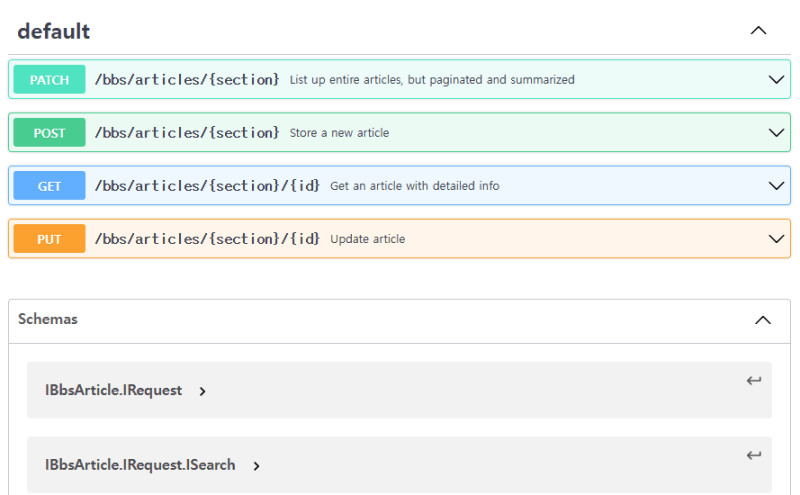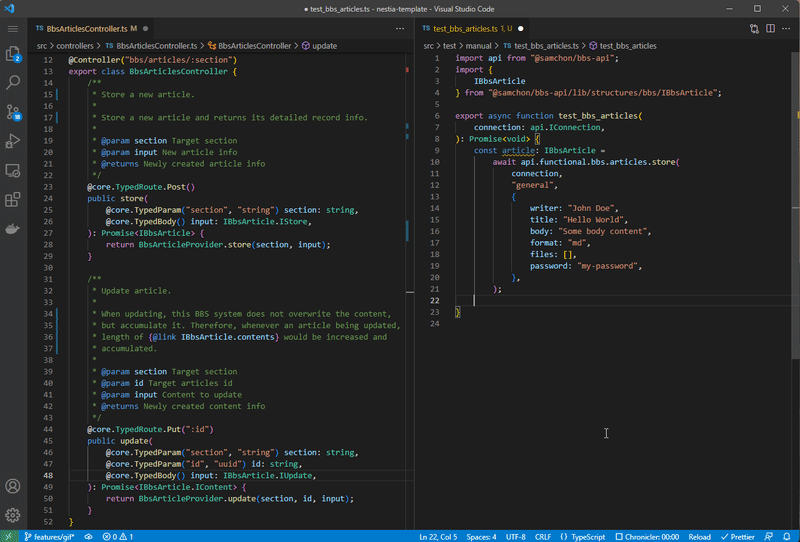Summary
If you're a frontend developer, stop using swagger-ui and msw.
Instead, you can build SDK (Software Development Kit) automatically.
- Which features SDK contain?
- Collection of
fetchfunctions - DTO structures written in TypeScript
- Mockup simulator for testing
- Collection of
- Github Repository: https://github.com/samchon/nestia
- Related Manual: https://nestia.io/docs/migrate
With the SDK, you don't need to be suffered from swagger documents reading and msw mocking anymore. You can only focus on your business logic, and build your frontend application much more quickly and safely.
Traditional way - swagger-ui
If you're a frontend developer, and have received swagger documents from backend, you may open it on swagger-ui.
Reading a swagger documents from swagger-ui, you may implement interaction code with backend server using axios or fetch function. You also need to write DTO (Data Transfer Object) structures looking at JSON schema definitions. Some professional frontend developers even build a mocking backend server through msw for testing.
During above processes, you may take a mistake that mis-reading API specs, or mis-writing DTO structures. Also, mocking the backend server with msw, you can misunderstand the real backend server's API specs. As long as front-end developers are human, not robots, these are all common mistakes we see all around us.
By the way, such common mistakes sometimes cause serious problems in the real world. At least, such mistakes never be caught by compiler, but only by runtime. The more mistakes we make, the harder it is to catch and debug. Of course, even if there are no mistakes, redundant DTO or fetch function implementation and msw mocking code by hand is very laborious and cumbersome works.
- Hand-writings
- fetch functions
- DTO structures
-
mswmocking code
- Redundant and laborious works
- Mistakes are not caught in compile time
New era - Software Development Kit
npm install -g @nestia/migrate
npx @nestia/migrate swagger.json outputDirectory
By the way, if such processes can be fully automated, how it would be?
Setup @nestia/migrate and run above build command. Then @nestia/migrate will analyze the target swagger.json file, and write TypeScript codes instead of you. The automatically generated TypeScript codes will contain all of the following features, and I call it as SDK (Software Development Kit).
-
fetchfunctions - DTO structures
- Mockup simulator for testing
Looking around the newly built SDK files, you can find that fetch functions are gathered into src/api/functional directory, and converted DTO types are stored into src/structures directory. When you open one of them, then you may understand how the SDK looks like.
Right is client (frontend) code utilizing SDK
For reference, left is migrated NestJS server code
Demonstration
Let's see how the SDK looks like with demo project.
You can repeat the same SDK generation process by typing below commands.
git clone https://github.com/samchon/nestia-template
cd nestia-template
npm install
npm run build:swagger
npm install -g @nestia/migrate
npx @nestia/migrate packages/api/swagger.json ../bbs
- Target
swagger.jsonfile: View in Swagger-UI - Generated SDK: samchon/nestia-migrate-examples/bbs/src/api
src/api/structures/IBbsArticle.ts
Comparing automatically generated TypeScript DTO structure type with original swagger.json file's JSON schema definition, you can find that it was perfectly converted. It succeeded to revive every property names and types exactly even including format comment tags.
export type IBbsArticle = {
/**
* Primary Key.
*
* @format uuid
*/
id: string;
/**
* Section code.
*
*/
section: string;
/**
* Name of nickname of writer.
*
*/
writer: string;
/**
* List of snapshot contents.
*
* Whenever updating an article, its contents would be accumulated.
*
*/
snapshots: Array<IBbsArticle.ISnapshot>;
/**
* Creation time of the article.
*
* @format date-time
*/
created_at: string;
}
src/api/functional/bbs/articles/index.ts
Automatically generated fetch function is also perfect.
/**
* Update article.
*
* When updating, this BBS system does not overwrite the content, but accumulate it.
* Therefore, whenever an article being updated, length of {@link IBbsArticle.snapshots}
* would be increased and accumulated.
*
* @param section Target section
* @param id Target articles id
* @param input Content to update
* @returns Newly created content info
*
* @controller BbsArticlesController.putById()
* @path PUT /bbs/articles/:section/:id
* @nestia Generated by Nestia - https://github.com/samchon/nestia
*/
export async function putById(
connection: IConnection,
section: string,
id: string,
body: IBbsArticle.IUpdate,
): Promise<putById.Output> {
return !!connection.simulate
? putById.simulate(
connection,
section,
id,
body,
)
: Fetcher.fetch(
connection,
putById.ENCRYPTED,
putById.METHOD,
putById.path(section, id),
body,
);
}
export namespace putById {
export type Input = IBbsArticle.IUpdate;
export type Output = IBbsArticle.ISnapshot;
export const METHOD = "PUT" as const;
export const PATH: string = "/bbs/articles/:section/:id";
export const ENCRYPTED: Fetcher.IEncrypted = {
request: false,
response: false,
};
export const path = (section: string, id: string): string => {
return `/bbs/articles/${encodeURIComponent(section ?? "null")}/${encodeURIComponent(id ?? "null")}`;
}
export const random = (g?: Partial<typia.IRandomGenerator>): Output =>
typia.random<Output>(g);
export const simulate = async (
connection: IConnection,
section: string,
id: string,
body: putById.Input,
): Promise<Output> => {
const assert = NestiaSimulator.assert({
method: METHOD,
host: connection.host,
path: path(section, id)
});
assert.param("section")("string")(() => typia.assert(section));
assert.param("id")("string")(() => typia.assert(id));
assert.body(() => typia.assert(body));
return random(
typeof connection.simulate === 'object' &&
connection.simulate !== null
? connection.simulate
: undefined
);
}
}
Also, looking at the above fetch function again detaily, you may find that SDK function is embedding mockup simulator code.
When connection.simulate property be configured, internal putById.simulate() function be called, and it checks the input parameters through typia.assert<T>() function. After the validations, the putById.simulate() function returns a random value through typia.random<T>() function.
This is the mockup simulator what I mean. It simply composes the mockup data just by using typia.random<T>() function, which has an ability that analyzing the target type T and generate perfectly typed matched random data.
Of course, if you don't want random mockup data, but want to compose it by yourself, just do it.
@nestia/migrate
In actually, I had developed @nestia/migrate for migration from other languages (or other frameworks) to NestJS. As I'm a big fan of NestJS, hoping much more backend developers to use NestJS in their backend projects, I had built such conversion tool.
Also, I had developed another convenient tool that generating SDK and mockup simulator for frontend developers. By the way, I suddendly realized that they can be combined together. Although, those SDK generator and migration tool had been developed for different purposes, if they are combined together, they can be a perfect tool for frontend developers, despite origin purpose was for backend development.
So, I combined them together, and introduce it in here article. Frontend developers, stop using swagger-ui and msw. Instead, let's use @nestia/migrate command to build SDK. Then, your frontend development would be much more easier, faster, and safer.
I think @nestia/migrate can be a new solution for effective frontend development. Do you agree with me?






Top comments (1)
The idea of automating processes that traditionally take up so much time and are prone to human error, is game-changing. The SDK you’ve introduced seems to be an efficient solution that could greatly streamline our workflows. I appreciate the detailed instructions and the thorough demonstration of how the SDK works, making it easy for anyone to understand and implement. I’m excited to try @nestia/migrate in my projects. Thanks for sharing this amazing tool!